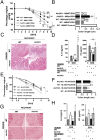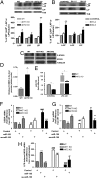Akt1 and Akt2 protein kinases differentially contribute to macrophage polarization
- PMID: 22647600
- PMCID: PMC3386059
- DOI: 10.1073/pnas.1119038109
Akt1 and Akt2 protein kinases differentially contribute to macrophage polarization
Abstract
Activated macrophages are described as classically activated or M1 type and alternatively activated or M2 type, depending on their response to proinflammatory stimuli and the expression of genetic markers including iNOS, arginase1, Ym1, and Fizz1. Here we report that Akt kinases differentially contribute to macrophage polarization, with Akt1 ablation giving rise to an M1 and Akt2 ablation resulting in an M2 phenotype. Accordingly, Akt2(-/-) mice were more resistant to LPS-induced endotoxin shock and to dextran sulfate sodium (DSS)-induced colitis than wild-type mice, whereas Akt1(-/-) mice were more sensitive. Cell depletion and reconstitution experiments in a DSS-induced colitis model confirmed that the effect was macrophage-dependent. Gene-silencing studies showed that the M2 phenotype of Akt2(-/-) macrophages was cell autonomous. The microRNA miR-155, whose expression was repressed in naive and in LPS-stimulated Akt2(-/-) macrophages, and its target C/EBPβ appear to play a key role in this process. C/EBPβ, a hallmark of M2 macrophages that regulates Arg1, was up-regulated upon Akt2 ablation or silencing. Overexpression or silencing of miR-155 confirmed its central role in Akt isoform-dependent M1/M2 polarization of macrophages.
Conflict of interest statement
The authors declare no conflict of interest.
Figures





Similar articles
-
Akt2 deficiency protects from acute lung injury via alternative macrophage activation and miR-146a induction in mice.J Immunol. 2014 Jan 1;192(1):394-406. doi: 10.4049/jimmunol.1300959. Epub 2013 Nov 25. J Immunol. 2014. PMID: 24277697
-
Akt2 Affects Periodontal Inflammation via Altering the M1/M2 Ratio.J Dent Res. 2020 May;99(5):577-587. doi: 10.1177/0022034520910127. Epub 2020 Mar 31. J Dent Res. 2020. PMID: 32228353
-
Fusobacterium nucleatum Aggravates the Progression of Colitis by Regulating M1 Macrophage Polarization via AKT2 Pathway.Front Immunol. 2019 Jun 12;10:1324. doi: 10.3389/fimmu.2019.01324. eCollection 2019. Front Immunol. 2019. PMID: 31249571 Free PMC article.
-
Macrophage polarization and function with emphasis on the evolving roles of coordinated regulation of cellular signaling pathways.Cell Signal. 2014 Feb;26(2):192-7. doi: 10.1016/j.cellsig.2013.11.004. Epub 2013 Nov 9. Cell Signal. 2014. PMID: 24219909 Review.
-
Akt Signaling Pathway in Macrophage Activation and M1/M2 Polarization.J Immunol. 2017 Feb 1;198(3):1006-1014. doi: 10.4049/jimmunol.1601515. J Immunol. 2017. PMID: 28115590 Review.
Cited by
-
M1 and M2 Macrophages Polarization via mTORC1 Influences Innate Immunity and Outcome of Ehrlichia Infection.J Cell Immunol. 2020;2(3):108-115. doi: 10.33696/immunology.2.029. J Cell Immunol. 2020. PMID: 32719831 Free PMC article.
-
Rosmarinic Acid Regulates Microglial M1/M2 Polarization via the PDPK1/Akt/HIF Pathway Under Conditions of Neuroinflammation.Inflammation. 2021 Feb;44(1):129-147. doi: 10.1007/s10753-020-01314-w. Inflammation. 2021. PMID: 32940818
-
Cyclosporine A alleviates colitis by inhibiting the formation of neutrophil extracellular traps via the regulating pentose phosphate pathway.Mol Med. 2023 Dec 13;29(1):169. doi: 10.1186/s10020-023-00758-8. Mol Med. 2023. PMID: 38093197 Free PMC article.
-
MicroRNA-mediated control of macrophages and its implications for cancer.Trends Immunol. 2013 Jul;34(7):350-9. doi: 10.1016/j.it.2013.02.003. Epub 2013 Mar 13. Trends Immunol. 2013. PMID: 23498847 Free PMC article. Review.
-
Regulation of Endotoxin Tolerance and Compensatory Anti-inflammatory Response Syndrome by Non-coding RNAs.Front Immunol. 2018 Nov 20;9:2705. doi: 10.3389/fimmu.2018.02705. eCollection 2018. Front Immunol. 2018. PMID: 30515175 Free PMC article. Review.
References
-
- Gordon S, Martinez FO. Alternative activation of macrophages: Mechanism and functions. Immunity. 2010;32:593–604. - PubMed
-
- Lawrence T, Natoli G. Transcriptional regulation of macrophage polarization: Enabling diversity with identity. Nat Rev Immunol. 2011;11:750–761. - PubMed
-
- Gray MJ, Poljakovic M, Kepka-Lenhart D, Morris SM., Jr Induction of arginase I transcription by IL-4 requires a composite DNA response element for STAT6 and C/EBPbeta. Gene. 2005;353:98–106. - PubMed
Publication types
MeSH terms
Substances
Grants and funding
LinkOut - more resources
Full Text Sources
Other Literature Sources
Molecular Biology Databases
Research Materials
Miscellaneous

